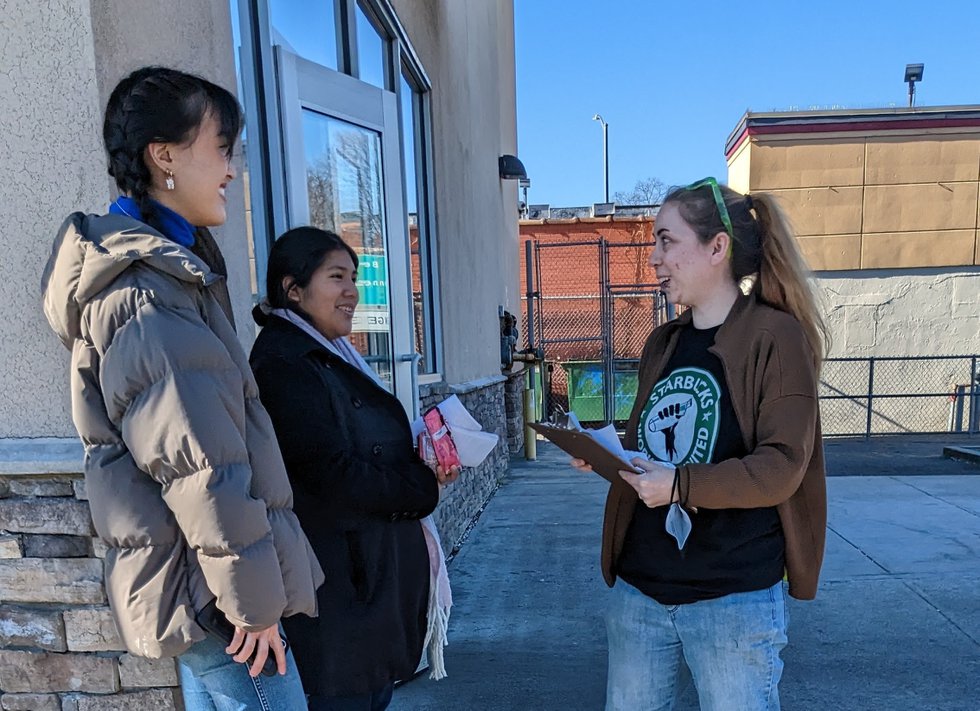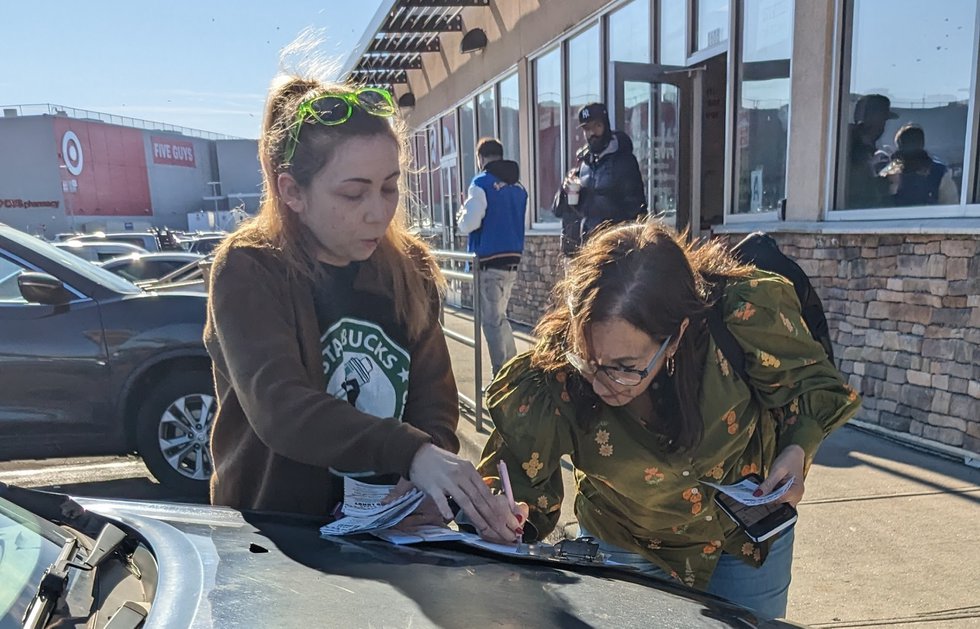“Do you want to support Starbucks workers? We’re short staffed. We’re a union store,” says Megan DiMotta in a heavy Brooklyn accent to customers entering the Bath Beach, Brooklyn location where she works as a barista.
The thirty-three-year-old and her coworker Jennifer De Jesus Sanchez were handing out flyers on a sidewalk near their store, part of a nationwide picketing action being held by the barista network Starbucks Workers United (SBWU) and its parent union Workers United. More than 110 Starbucks locations in total were picketed on February 14, SBWU told The Progressive.
“Why is my order taking so long?” reads a leaflet that DiMotta and De Jesus Sanchez were handing out. Through the flier, workers asked customers to sign a “No Contract, No Coffee” pledge or to call the Starbucks customer service line to express support for workers who say they are intentionally being left understaffed.
DiMotta said that at her store, staffing went from as many as twenty-seven workers at the time they filed to unionize down to twenty-one today, a roughly 20 percent drop. “Because Starbucks has been significantly cutting labor, that means stores are understaffed—but the customer pays the same price for their drink and waits even longer for their order,” says Jen Lenz, a barista in Peoria, Illinois, whose store did not participate in the Valentine’s Day action.
De Jesus Sanchez says that between mobile orders, deliveries, and orders in the store, work can get extremely chaotic for baristas. “Starbucks makes it seem like it’s our fault because [wait times] are long,” says DiMotta, “but it’s not our fault that we don’t have enough people.”

Starbucks baristas and a union staffer take a break from handing out flyers to discuss working conditions in Brooklyn, New York, February 14, 2023.
SBWU has claimed that the staffing cuts around the country are a retaliatory move in response to unionizing efforts.
“It’s unfair, because a lot of us like being here, we like doing our job when it doesn’t entail us being exhausted by running around the store, because we shouldn’t have to feel like that,” says DiMotta. “They’re trying to make us leave [our jobs].”
Falling on Valentine’s Day, the 110-plus actions were themed around the idea of Starbucks as a “toxic partner”—a play on Starbucks terming its workers “partners.” The informational pickets were the latest in a series of maneuvers by SBWU to attempt to push back against retaliatory actions by Starbucks.
The Starbucks union campaign’s roots are in Buffalo, New York, where in December 2021, baristas wonthe first union at a company-run store since the 1980s with the support of their parent union Workers United, an SEIU affiliate.
The win triggered a grassroots labor upsurge at Starbucks locations across the country in early 2022. In October 2022, the National Labor Relations Board reported a 53 percent increase in union filings, at Starbucks and elsewhere, over the previous year. Bargaining units for Starbucks workers are at the individual store level since the NLRB ruled in the baristas’ and union’s favor in 2021. In Starbucks’s corporate hierarchy, the stores are then organized into districts, and then regions.
After the rapid expansion of the Starbucks organizing drive from its home in Buffalo, however, the company began to crack down nationwide through union-busting tactics like cutting hours, selectively offering raises and better benefits to non-union stores, and firing about 200 SBWU baristas. New filings for unions at Starbucks stores nearly came to a halt.
Notoriously anti-union company leader Howard Schultz was brought back as a temporary chief executive for the corporation. “Do me a favor, don’t ever come back to Brooklyn. You’re not welcome here,” DiMotta says when asked about Schultz, who frequently talks about his upbringing in the borough.
By late 2022, after months of filing Unfair Labor Practice charges at the NLRB and frequent but uncoordinated strikes at the grassroots level, SBWU began to mount a coordinated counterattack. This culminated in two nationwide strikes of about 100 stores each at the end of the year.
While the barista campaign has not yet dented Starbucks’s revenues, the company may be vulnerable in the short term. It has a leadership transition, a Senate hearing on its labor practices, and a shareholder meeting all coming up in the next few weeks.
The Valentine’s Day action inaugurated the next phase of pushback by the barista network, with a renewed emphasis on reaching out to consumers.

During the Valentine’s Day picket at more than 100 Starbucks locations across the country, baristas asked customers to sign a “No Contract, No Coffee” pledge.
From Bath Beach to Buffalo to Maine, baristas and their supporters spoke to customers about the impact of Starbucks’s hour cuts on their lives. Both in southern Brooklyn and elsewhere around the country, baristas with whom The Progressive has spoken have reported a positive response.
“It went well, the customers are on our side,” says James Greene, a barista from Wilkins Township, Pennsylvania, a town outside of Pittsburgh, who participated in one of the actions.
But an SBWU staffer responsible for supporting baristas in stores in Maine reported that the company was less enthused; a Starbucks’s district manager came to a store in the area to try to suppress a picket.
So far, Starbucks continues to refuse to negotiate with baristas at the bargaining table, according to SBWU.
SBWU represents about 7,000 workers at more than 280 stores, but this is still only about 3 percent of the company-run Starbucks locations in the United States.
New union filings at Starbucks cafes have started trending upwards again, however—and the workers’ recognition that consumers will have a crucial role to play in their campaign augurs well for its success.